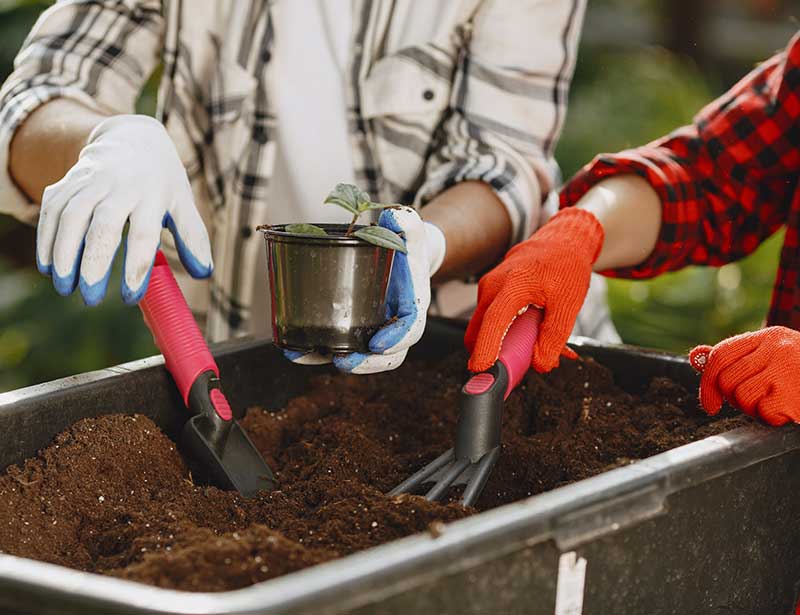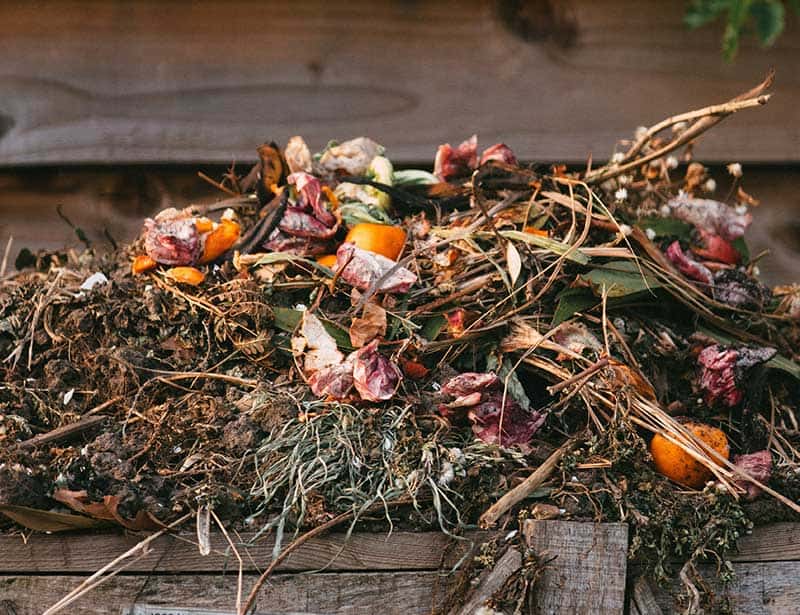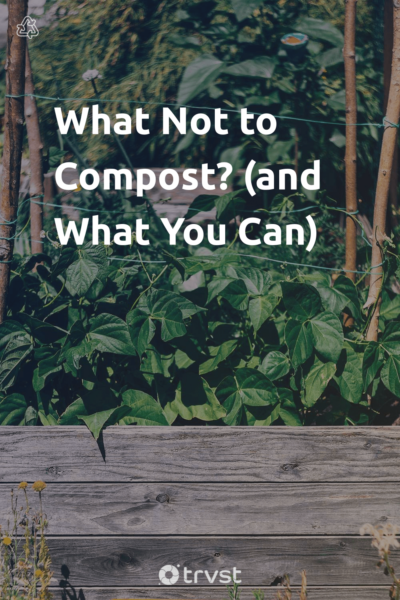What Not to Compost? (and What You Can)
With the right resources and materials, composting at home has become a straightforward process. Compost is an important ingredient that you can add to the soil to aid plant growth, helping your plants and garden to flourish. Below we cover what you can and what not to compost.
Waste such as food scraps and yard waste usually easily ends up in landfills. So besides its benefits to plants, turning waste into composting is an eco-friendly technique. Compost ingredients vary, so it’s easy to mix up what and what not to compost. This way, your compost pile will perform at its best, turning organic ingredients into nutrients.
What Can and Can’t You Compost?
What you can and what not to compost is an important one to answer before gathering material. If possible, you can create a list beforehand.
Composting is a natural process that speeds up the process of decomposing organic ingredients. All of this with the help of composting organisms. These include earthworms, fungi, millipedes, centipedes, sowbugs, and pillbugs. All organic materials decompose eventually. However, the composting process accelerates this process by providing the environment for organic waste to decay.
The result of the decomposed material is compost, which looks similar to garden soil. It is sometimes called “black gold”5. This is due to the valuable and rich nutrients composts contain.
We can source compost ingredients or organic materials within the home, garden, or yard. Within the home, food scraps need not go to waste and can hit the compost heap. From the garden or backyard, we can acquire green waste.
However, not all organic waste should be added to compost piles. This is especially important for piles created within the home and its environs. First, let’s examine the things we can add to compost.
What Can You Compost?

We can generally use things that grow from the ground in composting. It is important to note, however, that there are certain items that we should avoid. Before throwing waste in the compost bin, determine what should and should not go in the compost pile. By identifying these items, you save yourself the trouble of ruining your plants and garden. Collecting the right things will ensure your compost heap is rich in nutrients and beneficial to the soil.
It is important to note that organic matter in all its forms contains carbon and nitrogen. The carbon exists in substantial amounts with lesser amounts of nitrogen. You should aim for your pile to reflect the right amount of carbon and nitrogen for optimal conditions.
Carbon is for energy, while nitrogen is essential for producing protein. Ideally, the carbon-to-nitrogen ratio in compost heaps should be 25-30:1. That is 25-30 parts carbon to 1 part nitrogen.
A compost pile should comprise three key ingredients. You should consider these ingredients when putting items in the compost bin to create the proper moisture balance. They are brown materials, green waste, and water.
Brown materials include twigs, dead plants, sawdust, branches, and other dry or wood-like plant materials. Greens are high in nitrogen and consist of materials such as coffee grounds, tea bags, grass clippings, fruits and vegetable scraps, eggshells, and general food waste. Although coffee grounds are not green in color, they have high nitrogen content.
Browns
These items are high in carbon. They are usually brown or dark colored. Brown materials are often dry, and they decompose slowly. They serve as energy-giving sources to beneficial composting organisms that break down the contents in a compost pile.
Greens

Unlike the browns, green material decomposes quickly and is high in moisture. Greens serve as a good nitrogen source. They are essential for the growth process and reproduction of beneficial organisms. Having a substantial amount of these items, such as grass clippings in the compost pile or heap is necessary. It aids the growth and reproduction process of the organisms needed for composting.
If you’re looking at a waste material and wondering ‘can I compost it?’, below is a list of what can be composed:
- Cardboard
- Coffee grounds
- Fruit and vegetable scraps
- Shredded newspaper
- Eggshells
- Dried leaves
- Seaweed
- Grass clippings
- Hay and straw
- Wood chips
- Sawdust
- Hair and fur
- Dried grass
- Wine corks
- Vacuum cleaner lint
- Tea Leaves
- Fireplace ashes (avoiding coal ash)
- Sawdust
These items can be added to your backyard compost heap or indoor piles. Simply collect all these in a compost bin. It is important to note that plant diseases could pose a problem in a home compost pile.
Although diseases in plants tend to break down in high temperatures, home compost heaps may not reach such degrees of temperature4. To better understand what can and can not be composted, read on to identify things that you should not add to compost and why.
What Can’t You Compost?
Understanding what not to compost is crucial to the value of your pile. Whereas most homes will make sure those grass clippings and coffee grounds make the pile, there are certain materials that you should avoid. These can be detrimental to the soil and plants, cause problems in the garden, and lead to odor problems.
Further, they can even attract unwanted pests and animals. To create a successful and useful compost pile, it is best to avoid these things.
Pet waste
Pet wastes such as dog and cat feces (including soiled cat litter) can be toxic to human health. The waste contains bacteria, parasites, and germs that can cause a health risk. These toxic components can make their way into the body, especially when used in compost for consumable crops.
Although they use dog waste in commercial composting, you should not compost it at home. This is because composting at home may not have sufficient heat to control pathogens. However, you can compost waste from animals such as rabbits, cows, and horses can be used when composting.
Dairy products
Although dairy products are organic matter, you should not compost them at home. Food waste is susceptible to producing odors during the composting process. Naturally, these products will decompose, but the smell of dairy can attract pests and animals that will raid the compost bin.
Dairy products include milk, yogurt, butter, and eggs. You should also avoid other animal products such as fish, bones, meat scraps, and meat products for this same reason. Or, in fact, anything that carnivorous animals or rats might like to avoid problems with pests.
However, one trick you might try is to bury some of these more risky items under a large layer of other compost material to avoid the odor problem which attracts pests.
For more info: Can You Compost Cheese and Dairy Products?
Diseased plants
You should not compost plants with diseases. This is because they contain fungus that can affect the efficacy of the compost. Diseases in plants can also survive in composts and further spread to healthy plants. Although these diseases can be killed, they require efficient composting facilities or high temperatures.
Note also take care to avoid toxic plants such as the black walnut tree leaves. As much as we might like black walnut trees in the garden, they can kill other species if you don’t treat trimmings with care.
Cooking oil
You should avoid cooking oil in home compost bins as it serves as food for some pests and rodents. It also contains some level of chemical content that can affect the compost nutrients. Coal ash from BBQs and the like can also contain chemicals, making them unfriendly to compost bins.
Inorganic matter
Inorganic matter is basically anything not derived from living organisms. Do not try and compost these at home as they take too long to break down or decompose, and they lack carbon. Inorganic matter includes metals, plastics, rubber, polyester, aluminum foil, and glass.
Also, avoid wrapping paper or glossy paper, which often contains metal or plastic to provide its sheen. The same goes for treated wood. Paper towels and cereal boxes may make the grade if they don’t contain too much gloss or inorganic glue and feel natural.
Related: Some items can prove a little more complicated, check out our guide to can you compost pizza boxes and biodegradable vs compostable.
Large branches
You can add branches to compost. However, you need to cut these branches into small pieces to allow a smoother process. Large branches take longer to break down and delay the process of using compost for plants and in the garden.
Elsewhere in the garden, be mindful of tomato plants and other seeded fruit that might mean you end up with little plants everywhere when you didn’t really want them.
Citrus Peels and Onion Scraps
Citrus peels and onion scraps also fall under the category of what not to compost. Although you can add fruits and vegetables to composts, citrus peels, onions and garlic scraps are exceptions. These things have acidity and natural chemicals that can slow down the process of composting. This is because their harsh contents can kill composting organisms present in green materials.
Read more: Can You Compost Rice for Sustainable Leftovers?
Wood or trimmings treated with chemicals.
Several pesticides or herbicides can be harmful to plants and vegetables that require compost to grow.
The list of what not to compost is inexhaustible. Other things that fall under the ‘what not to compost’ category include stickers on fruits and vegetables, black walnut tree leaves for vegetable garden compost, coated or glossy paper, synthetic fertilizer, and plastic tea bags or coffee bags (because some tea bags have synthetic fibers or plastic linings that take much longer to decompose).
You can compost saw dust providing it doesn't come from treated wood. When natural saw dust can also help dry out wet heaps.
Can I Compost Bread?
The question of including bread and bread products in the composting bin is an important one. The primary justification against adding bread to your list of what not to compost is that it attracts pests.
However, bread, even in its stale form, makes a great addition to composting. Rodents, pests, and other animals find food like bread attractive. If you have a home compost well protected from pests, bread might work just fine. However, if not, you’ll find it best to avoid putting bread in the compost.
On the pro side, bread breaks down fast when added to compost. It is also a beneficial ingredient. If you’re bent on preventing bread waste from ending up in the trash, it’s important to invest in good and quality compost bins. These will ensure the right environment for compost and keep animals out.
Can I Put Rotting Vegetables In Compost?
We can add rotten fruits and vegetables to compost, with a few preventive methods for some conditions. Composting prevents them from going to waste. They also provide nitrogen to compost. They serve as valuable additions to the soil and plants when combined with other compost items.
Vegetables contain a significant amount of nutrients that can aid the growth of microorganisms2. They are beneficial in the pile to help the process. Rot occurs as part of the deterioration or decomposing process in fruits and vegetables. To understand the process of decomposition in vegetables better, here are four deterioration factors7:
Enzymes
Enzymes act as biological catalysts that speed up the fruit and vegetable ripening process. Over time, this will lead to over-ripening, causing the physical appearance of fruits and vegetables to turn brown. Eventually, it will render them inedible. When fruits and vegetables are over-ripe, we can still add them to compost.
Physical Changes
This occurs with dehydrated vegetables. They absorb moisture due to an inadequate barrier in packaging, which leads to humidity caking3.
Chemical Changes
Chemical reactions cause changes in the color and flavor of vegetables. This is primarily due to oxidation, which causes various reactions. However, such reactions are not harmful to the soil and compost pile.
Biological Changes
There are two divisions of biological changes in vegetables; microbiological and macrobiological changes.
For microbiological changes, microorganisms cause reactions in vegetables, leading to a breaking-down process. However, some of these microorganisms are not beneficial to composting, while others are.
For instance, botulism toxins are harmful to humans if present in canned vegetables. It is best to avoid canned foods or jars that are damaged, squirt liquid, foaming, swollen, and leaking. They are dangerous and harmful if you come in contact with the contents. This can be toxic to your compost pile. Canning vegetables at home are the most common cause of botulism in the United States8.
On the other hand, insect infestation or rodent attacks cause macrobiological changes. If your finished compost is infested with damaging bugs and insects, this will negatively affect the plants you’re growing. To avoid this, you need to raise the temperature of the heap to above 120°F.
What Are the Downsides of Composting?
Composting is beneficial for reducing waste in landfills, improving soil nutrients, and recycling many products. However, the process has shortcomings that have popularised chemical synthetic fertilizers as an alternative to compost. These challenges, or negative aspects, reduce the efficiency and large-scale use of compost. Below are some of the downsides of composting when thinking about what not to compost:
Odor Production
One of the most significant cons of compost odor problems. Asides from small-scale odor production, there are also those from composting facilities. For instance, anaerobic composting releases a considerable amount of methane into the environment. This method uses microorganisms in the absence of oxygen and releases methane. This results in a bad odor problem that can make staying around such a place impossible.
Health Risks
Health risks can arise from pungent odors and other factors such as contaminants in compost. This can pose health risks to different categories of people. This includes individuals who produce compost, farmworkers, and people that consume products derived from soil treated with compost1. Methane, which is a by-product of anaerobic composting, is toxic. It is a powerful greenhouse gas that is 26 times more potent than carbon dioxide6. High amounts of this gas can cause vision problems, headaches, memory loss, and slurred speech.
Composting Takes Time
The process of composting takes a long time before the compost is ready for use. This requires a lot of patience due to the long wait. If the organic matter has not completely decomposed, you cannot use the compost for the soil. You need to regularly attend to your compost pile to ensure the process takes place correctly and without problems.
Toxic to the Environment
About the earlier mention of methane, this gas is also harmful to the environment. Greenhouse gases contribute to global warming and climate change. This is even more catastrophic when we produce these gases on a large scale, for instance, in landfills.
Additional Fertiliser in Compost Pile
When asking what not to compost, you might find you need a little help with missing ingredients. Sometimes, you may need to include additional fertilizer in your compost heap because some compost heaps are low in nutrients which can slow down the decomposition process.
The level of nutrients in a compost pile largely depends on the amount of organic waste. So, in a household that does not produce a significant amount of organic waste, compost nutrients will be fewer. The addition of chemical fertilizers is detrimental to the purpose of composts. These fertilizers contribute to the death of organisms in the soil, pollution, and greenhouse effects.
To produce quality composts, you need to pay attention to the quality of organic waste in tune with the ideas above about what you can and can’t compost. You should also consider the carbon-nitrogen ratio of the compost alongside the balance of brown and green materials.
Conclusion
When composting, especially at home, with a little thought about what goes in, with the best outcomes in mind, you can produce high-quality compost perfect for your garden beds and homegrown veg. What to add to compost and what not to add to compost are essential considerations. Composting has many benefits. However, doing it wrong can be detrimental to the soil, food products, and human health.
| 1 |
Domingo, J. L., & Nadal, M. (2009). Domestic waste composting facilities: a review of human health risks. Environment international, 35(2), 382-389. https://doi.org/10.1016/j.envint.2008.07.004 |
| 2 |
Stella, M., & Sashikala, M. (2016). Beneficial microorganisms isolated from vegetable compost. Journal of Tropical Agriculture and Food Science, 44(2), 277-293. |
| 3 |
Gustavo V., Anthony J., Shelly J., & Theodore P. (2020). Water Activity in Foods: Fundamentals and Applications, Second Edition (pp. 453-464). DOI:10.1002/9781118765982 |
| 4 |
University of California Division of Agriculture and Natural Resources. (2009). Composting is Good for Your Garden and Environment. Publication 8367. |
| 5 |
Cho, R. (2012, October 8). Composting—Turning Garbage into Black Gold. |
| 6 |
Department of Primary Industries and Regional Development. (2018, July 23). Composting to avoid methane production. |
| 7 |
Dauthy, M. E. (1995). Fruit and vegetable processing (pp. 32-38). FAO. |
| 8 |
Centers for Disease Control and Prevention. (2019, June 6). Botulism |
Jen’s a passionate environmentalist and sustainability expert. With a science degree from Babcock University Jen loves applying her research skills to craft editorial that connects with our global changemaker and readership audiences centered around topics including zero waste, sustainability, climate change, and biodiversity.
Elsewhere Jen’s interests include the role that future technology and data have in helping us solve some of the planet’s biggest challenges.

